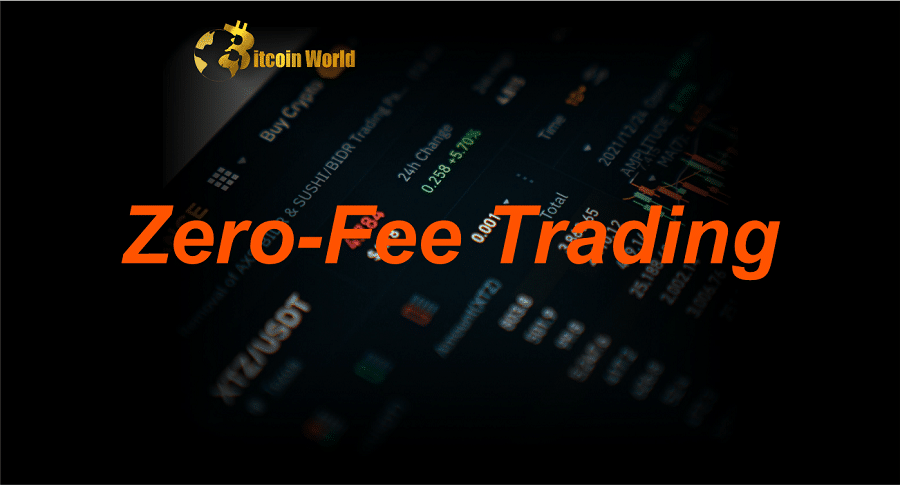Is the golden age of zero-fee Bitcoin trading coming to an end? For crypto enthusiasts and traders, Binance’s recent move to roll back its zero-fee trading for most Bitcoin pairs has sent ripples through the market. After a mere nine months of attracting traders with the allure of commission-free BTC transactions, the world’s leading cryptocurrency exchange by trading volume is changing course. What does this mean for Binance, the competitive landscape, and the stablecoin TrueUSD (TUSD)? Let’s dive into the details.
Why Did Binance Say Goodbye to Zero-Fee Bitcoin Trading?
On Wednesday, Binance initiated a gradual phase-out of its $0 fee policy for buying and selling Bitcoin (BTC) across numerous trading pairs. The only exception? Trading with the stablecoin TrueUSD (TUSD). This strategic pivot by Binance could be a landmark moment, potentially signaling a broader shift away from zero-fee models among centralized crypto exchanges and challenging Binance’s commanding market position.
Consider this: Kaiko, a renowned cryptocurrency market data firm, reports that these zero-fee trading pairs accounted for a staggering 60% of Binance’s total trading volume. Ending this incentive is a bold move, and market analysts are keenly observing its impact. Furthermore, this decision throws a spotlight on TrueUSD (TUSD), suggesting it might be stepping into the limelight as Binance’s preferred stablecoin partner.
The Zero-Fee Strategy: A Market Share Grab?
Rewind to last summer’s market downturn. Crypto exchanges faced a tough environment – dwindling trading volumes and shrinking profits. It was in this climate that Binance launched its zero-fee trading initiative for select BTC pairs globally. This wasn’t just a promotion; it was a calculated strategy. Clara Medalie, the sharp-minded research director at Kaiko, points out that this move was instrumental in Binance’s dramatic market share growth.
According to Kaiko’s data, Binance’s market share surged from 50% in July to an impressive 72% when measured against the most liquid exchanges. Zero-fee trading acted like a powerful magnet, attracting traders and consolidating Binance’s dominance.
Unsustainable Success? The Long-Term View
While zero-fee trading can be a potent tool for short-term gains, is it a sustainable model in the long run? Medalie, in her insights shared with Coindesk, suggests not. “Zero-fee trading is unsustainable in the long run, but it allowed Binance to quickly obtain a significant amount of market share,” she stated. The current rollback indicates a recognition of this unsustainability. “We could anticipate a short-term decline in market share without zero costs for the majority of BTC pairs,” Medalie predicts. This potential dip is the trade-off Binance seems willing to make for long-term financial health and strategic positioning.
TrueUSD (TUSD): Riding the Stablecoin Wave
The story of TrueUSD (TUSD) is intertwined with the regulatory headwinds faced by Binance USD (BUSD). When authorities, particularly in New York, took action against BUSD, it created a vacuum in the stablecoin space on Binance. The New York Department of Financial Services (NYDFS) instructed Paxos, the issuer of BUSD under Binance’s brand, to halt the minting of the stablecoin. The impact was immediate and significant – BUSD’s supply plummeted from $16 billion to $8 billion.
Enter TrueUSD (TUSD). As BUSD’s star waned, TUSD’s ascended. Medalie suggests that Binance has strategically positioned TUSD as a likely successor. The numbers speak for themselves: following the announcement of BUSD’s phase-out, TUSD’s market capitalization more than doubled, reaching a solid $2 billion, as reported by CoinGecko. This surge in market cap underscores the market’s rapid adoption of TUSD.
The Players Behind TrueUSD
Who is behind this rising stablecoin? The intellectual property of TrueUSD was acquired by Techteryx, an Asian investment firm that remains relatively unknown. Archblock, previously known as TrustToken, is responsible for managing the stablecoin’s operations. Intriguingly, rumors have circulated suggesting that Justin Sun, the founder of Tron and a well-known figure in the crypto world, was the originator of TUSD. However, these claims have been officially denied by the company.
Key Takeaways: Binance, Zero-Fee Trading, and the Future
Let’s summarize the key points and what they might mean for the crypto market:
- Binance’s Strategy Shift: Ending zero-fee trading for most BTC pairs marks a significant change in Binance’s strategy, moving away from aggressive market share acquisition towards potentially more sustainable revenue models.
- Market Share Impact: A short-term decrease in Binance’s market share is anticipated as traders who were primarily attracted by zero fees may explore other platforms. Competitors will be watching closely to see if they can capitalize on this shift.
- TrueUSD’s Ascendancy: TUSD is emerging as a key stablecoin partner for Binance, benefiting from the regulatory challenges faced by BUSD. Its growing market cap and Binance’s promotion signal a strong vote of confidence.
- Stablecoin Dynamics: The episode highlights the dynamic nature of the stablecoin market, influenced by both market forces and regulatory actions. The rise and fall of stablecoins can have significant implications for exchange ecosystems.
- Long-Term Sustainability: The move away from zero-fee trading underscores a broader industry consideration – the need for sustainable business models for crypto exchanges. While zero fees can attract users, they are unlikely to be a viable long-term strategy for most platforms.
What’s Next?
The cryptocurrency exchange landscape is ever-evolving. Binance’s decision to adjust its zero-fee policy is a reminder of the constant shifts and strategic realignments within this dynamic market. As Binance navigates this transition, the industry will be keenly observing the impact on its market share, the growth trajectory of TrueUSD, and the broader implications for trading fees and stablecoin preferences across exchanges. One thing is clear: the era of aggressive, unsustainable zero-fee promotions might be giving way to a more balanced and mature phase in the crypto exchange world.
Disclaimer: The information provided is not trading advice, Bitcoinworld.co.in holds no liability for any investments made based on the information provided on this page. We strongly recommend independent research and/or consultation with a qualified professional before making any investment decisions.


